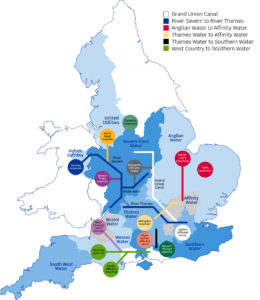We’re all too aware that climate change is a present reality, not least with the drier, hotter summers and increase in flooding. Add the growing pressure from population growth and economic development, and you can clearly see why there is concern about the impact on water supply resilience.
The National Infrastructure Commission (NIC) estimated that new water supplies equivalent to the water consumed by over nine million people would be needed in England by the mid 2030s. The Environment Agency also stated that if no action is taken between 2025 and 2050, there will be a shortfall of around 4,000 million extra litres of water per day in public water supply.
In short, water resilience matters.
In our view, there are three core strands to this: tackling leakage, reducing demand, and increasing supply.
New sources of supply
The Regulators’ Alliance for Progressing Infrastructure Development (RAPID) was formed to help facilitate the development and funding of new, large-scale strategic water supply infrastructure by the water companies. RAPID is a partnership made up of three water regulators – Ofwat, the Environment Agency (EA) and the Drinking Water Inspectorate (DWI) and was set up in 2019.
Overseen by RAPID, the industry is currently working on 18 major, cross-country projects that together would deliver enough water for 10 million people. These projects include schemes to transfer water from where there is enough, to where there is less; recycling and reusing water; and developing new reservoirs. Water companies are working together to develop these solutions, some of which could benefit more than one region.
Current schemes are spread across the breadth of the country. The map below shows how water could be shared across the country if they all go ahead.
We anticipate that not all the proposed solutions will progress to construction. The RAPID programme is designed to ensure that only the right solutions, at the right cost and that have the least impact on the environment, will progress to development.
As there is a very urgent need to plug the gap between supply and demand in parts of the South East of England, solutions in this region are on an accelerated process and should be providing water by 2030. The other solutions across the country are likely to be construction ready by 2025-30.
Leakage reduction
A reduction in leakage is also key to ensuring that we have the water we need for the future. At Ofwat, we’ve tasked water companies with cutting leakage by 16% in the five years to 2025.
Last year, 13 of the 17 water companies met their leakage targets and we saw an overall reduction of leakage by 4%. Since 2017-18, leakage is down 11%. Companies are on the right path, but there is a lot more to do.
Demand management
By international comparison, people in England and Wales use a lot of water. We want to see water companies helping customers to reduce their usage of water by bringing technological and behavioural changes that can help us all to use water wisely. Customers reducing their usage can help safeguard the environment and will mean that supplies last longer
We also need other sectors help to respond to the challenge – for example, in terms of appliances in our homes and new build properties having water efficiency as a guiding principle and badge of honour.
We’re already seeing a number of ideas coming through our Innovation Fund that address leakage, demand and supply issues. Ideas like these along with the approaches that we are taking could help to ensure that we have resilient water sources for the future.
We’ll continue to push for companies to do more. We want them to step up on their leakage reduction, we want them to do more to provide support to customers to use water wisely and we want them to continue collaborating with others in the water industry to solve the long-term challenges.
